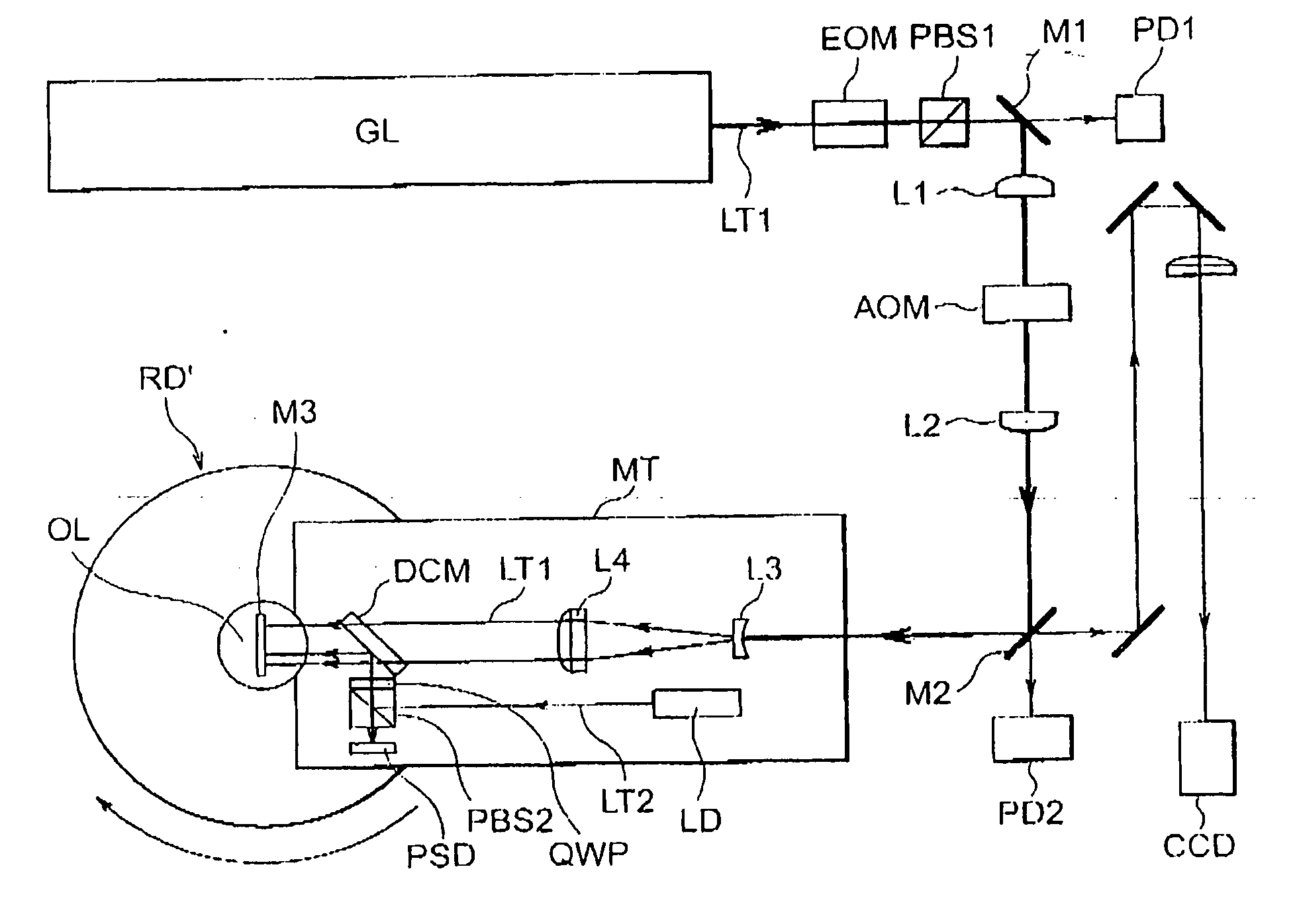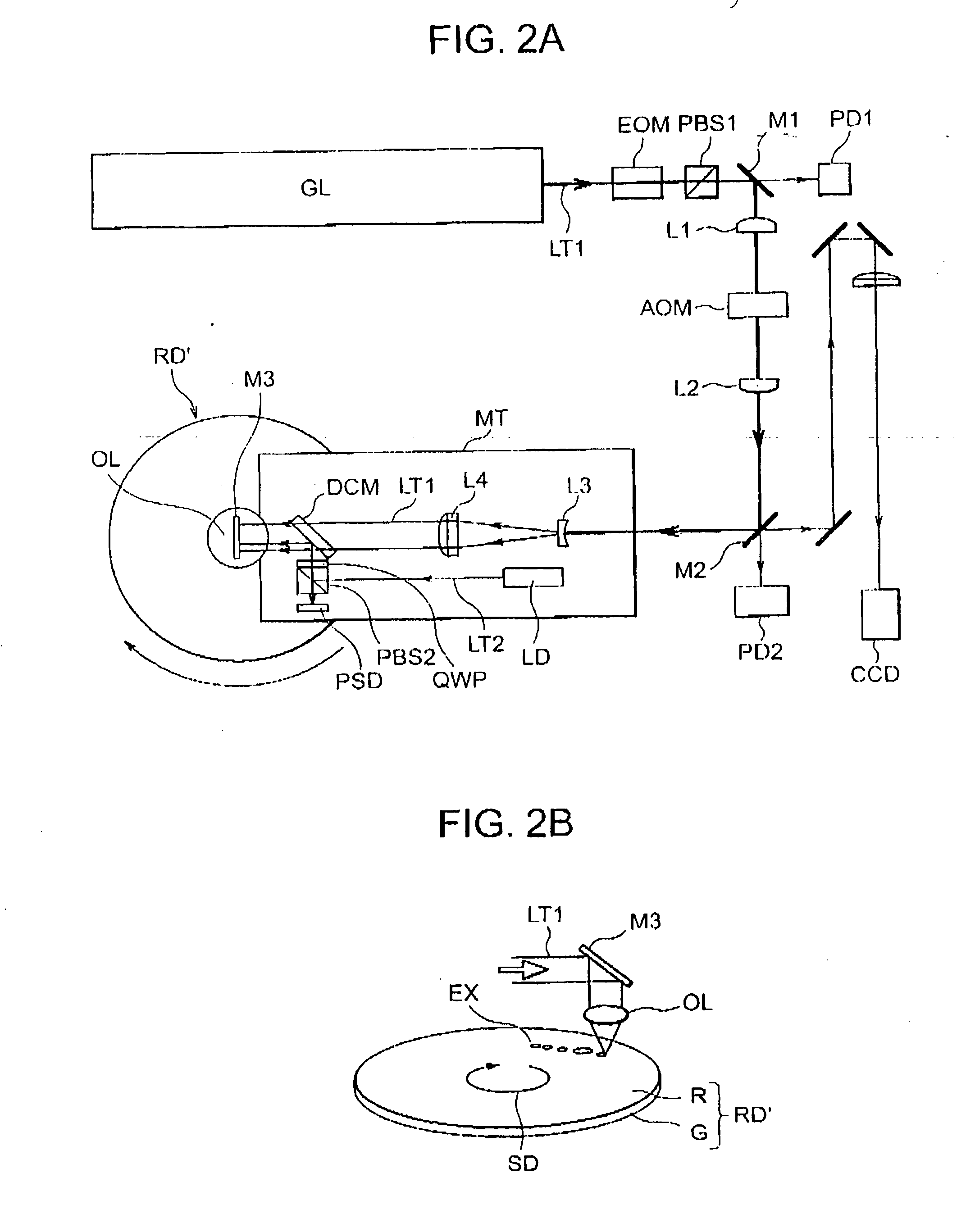Stamper for producing optical recording medium, optical recording medium, and methods of producing the same
a technology of optical recording medium and stent, which is applied in the direction of flat record carrier container, record information storage, packaging, etc., can solve the problems of uneven thickness of inner and outer circumference, insufficient signal-to-noise ratio, and insufficient effect, so as to reduce the residual discrepancy of focus error, reduce the low frequency noise of disk signal, and improve the crosstalk characteristic
- Summary
- Abstract
- Description
- Claims
- Application Information
AI Technical Summary
Benefits of technology
Problems solved by technology
Method used
Image
Examples
first embodiment
[0129]FIG. 7A is a schematic perspective view of a condition of irradiating an optical disk according to the present invention with light.
[0130] An optical disk DC is substantially shaped as a disk with a center hole CH formed at its center and is driven to rotate in a drive direction DR.
[0131] When recording or reproducing information, a laser light of a blue to bluish violet color region or other light LT is focused on an optical recording multilayer film in the optical disk DC by an object lens OL having a numerical aperture of for example 0.8 or more.
[0132]FIG. 7B is a schematic cross-sectional view, while FIG. 7C is an enlarged cross-sectional view of principal portions of the schematic cross-sectional view in FIG. 7B.
[0133] One surface of a disk substrate 12 having a thickness of about 1.1 mm and comprising polycarbonate, is provided with projecting regions 12a and recessed regions 12b defining track regions. That surface is further formed with an optical recording multila...
second embodiment
[0187]FIG. 12A is a schematic cross-sectional view of an optical disk of a second embodiment.
[0188] One surface of a disk substrate 20 having a thickness of about 1.1 mm and comprising polycarbonate is formed with projecting regions and recessed regions defining track regions. For example, a reflection film, a dielectric film, a recording film, another dielectric film, etc. are stacked in this order on this surface to form a first optical recording multilayer film 21. The configuration and number of layers of the first optical recording multilayer film 21 differ according to the type of the recording material and design. The above recording film includes for example a phase change type recording film, a magneto-optical recording film, and an organic pigment-containing recording film.
[0189] Further, over the first optical recording multilayer film 21 a second optical recording multilayer film 24 is formed via a light transmitting layer 22 comprising an ultraviolet curing resin etc....
third embodiment
[0215]FIG. 15A is a schematic cross-sectional view of an optical disk according to a third embodiment.
[0216] One surface of a disk substrate 34 having a thickness of about 1.1 mm comprising polycarbonate etc. is provided with projecting regions and recessed regions defining track regions. For example, a reflection film, a dielectric film, a recording film, another dielectric film, etc. are stacked in that order on this surface to form a first optical recording multilayer film 35. The configuration and number of layers of the first optical recording multilayer film 35 differ according to the type of recording material and design. The above recording film includes for example a phase change type recording film, a magneto-optical recording film, an organic pigment-containing recording film.
[0217] Further, over the first optical recording multilayer film 35 a second optical recording multilayer film 33 is formed via a light transmitting layer 36 comprising an ultraviolet curing resin ...
PUM
| Property | Measurement | Unit |
|---|---|---|
| Circumference | aaaaa | aaaaa |
Abstract
Description
Claims
Application Information
 Login to View More
Login to View More - R&D
- Intellectual Property
- Life Sciences
- Materials
- Tech Scout
- Unparalleled Data Quality
- Higher Quality Content
- 60% Fewer Hallucinations
Browse by: Latest US Patents, China's latest patents, Technical Efficacy Thesaurus, Application Domain, Technology Topic, Popular Technical Reports.
© 2025 PatSnap. All rights reserved.Legal|Privacy policy|Modern Slavery Act Transparency Statement|Sitemap|About US| Contact US: help@patsnap.com



